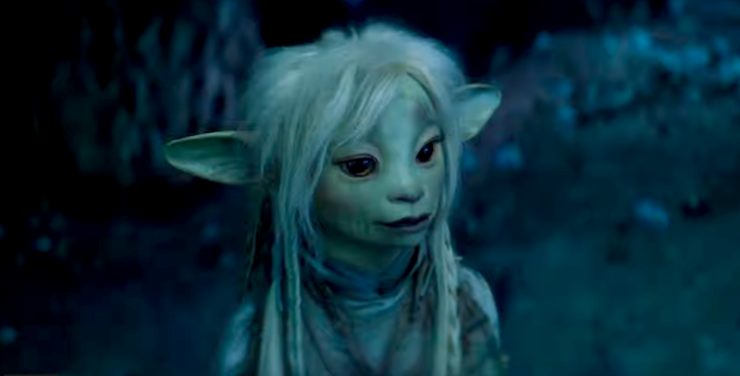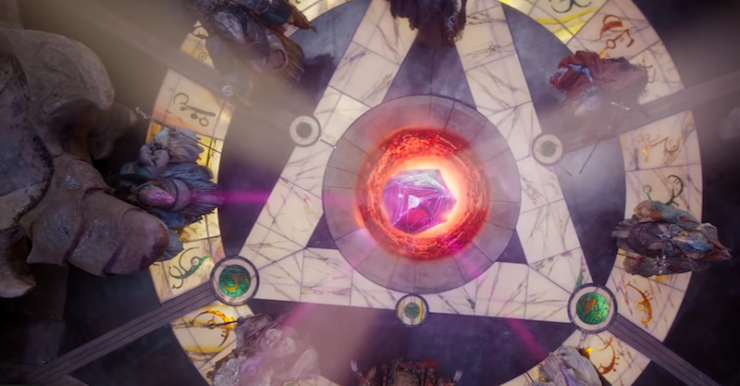When The Dark Crystal first premiered in 1982, it fueled the dreams and nightmares of many children, but it also represented a dream of Muppets-creator, Jim Henson—to bring puppetry into new and darker creative realms, recognized as an art form that could be used in complex storytelling. While The Dark Crystal was a modest box office success, 1986’s Labyrinth didn’t recoup its budget, and Henson’s death in 1990 slowed the company’s forays into projects of such scale. The Jim Henson Creature Shop continues to do exemplary work in its creation of puppets for film and television, but productions that truly rely solely on puppetry for visual effects remain few and far between.
Given the state of things, The Dark Crystal: Age of Resistance is perfectly poised to remind us all of what we’re missing.
Though it receives cult classic status by many metrics, The Dark Crystal suffered as a film for one key reason—it was simply too much story for a single movie. The work done by Henson, screenwriter David Odell, and concept artist Brian Froud encompassed an entire fantasy world, full of symbols and mythology and peoples, and what audiences saw on screen barely scratched the surface of what was created in its service. In addition, audiences nearly forty years ago were less accustomed to watching whole fantasy epics play out cinematically. It would take the popularity of sagas like Lord of the Rings and Harry Potter, and then Game of Thrones, to make that kind of storytelling more common on film.
But the lore of the universe The Dark Crystal unleashed was always there, just waiting for an opportunity to resurface.
After Henson’s death, the Jim Henson Creature Shop focused primarily on “creature effects” for countless film and television projects, from Dr. Dolittle to Babe to Where the Wild Things Are. For science fiction fans, they are undoubtedly best known for their work on the cult hit show Farscape, using puppetry alongside computer graphics in precisely the way that Jim Henson dreamed. The recent shift towards fantasy in popular storytelling and new production models made The Dark Crystal’s return a viable and desirable exercise, and the Jim Henson Company was given leave to do what they’ve always done best—bring the impossible to life with a depth and vibrancy and is rarely achievable in CGI no matter how advanced the technology becomes.
While special effects houses continue to refine CGI, we’ve reached a point where their advancement is no longer a priority for most projects. When The Two Towers was released in 2002, audiences and critics alike praised the transcendental effects created by Weta Workshop in the rendering of Gollum, using motion capture technology and computer animation. The trouble is, though the Lord of the Rings trilogy is nearly two decades old, it’s rare to see special effects that surpass (or even equal) what those films achieved. Budget and time are major factors in this issue—that kind of work takes a lot of money that plenty of studios would rather just not spend, and a time crunch in production can run roughshod over any attempt at realism. This has led to giant blockbusters sporting oddly subpar graphics even in recent memory, whether it’s a Justice League film rendered deeply uncanny due to a need to remove Superman’s mustache, identical elven warriors copy-pasted onto a battlefield in the final Hobbit film, or central characters being obviously stitched into composite group shots during Avengers: Infinity War (looking at you, Bruce Banner). The now relative ease of adding CGI anywhere on film can result in overuse or a striking lack of quality control.
So when I say that The Dark Crystal series is not only enjoyable but a welcome relief, perhaps you’ll know exactly what I mean.
The show is glorious because nothing else on offer these days can or will compare to it. There are special effects, certainly, but so much of what we’re shown is physical, built, can be touched. Someone had to draw it, mold it, come up with the mechanics that drive it, perform inside of it. The world itself can’t rely on real landscapes that can be scoped out by set scouts, it has to be painstakingly constructed in every detail. Matching this manner of creation with the intricate backstories and careful worldbuilding of the fantasy genre isn’t only a delight to watch, but a perfect alignment of well-suited skills. In some ways, it feels strange that we only had one tale set in this world before now; this is the natural path that the story seems designed to take, with this level of scale.

While it sports an all-star cast of excellent actors, it speaks to the beauty of what we see on screen that the performances of the puppets and the scope of the world Thra really do take precedence over the voice talent. Of the few standouts, Nathalie Emmanuel’s Deet steals the show in places, and Simon Pegg’s pitch-perfect replication of the late Barry Dennen’s grating hum in the role of skekSil (The Chamberlain) is frequently terrifying. Donna Kimball also nails it with her performance of Aughra, which is a tough role to take up in absence of her originator, Billie Whitelaw. There’s also a particular duo whose relationship I won’t spoil, but the characters in question are voiced by Andy Samberg and Bill Hader, and their presence in the story is an absolute treat for a number of reasons.
The strengths of this new Dark Crystal series are manifold, with a rich world to be explored and a timely message attached—the story reads as a direct analogue to the terror of climate catastrophe that currently endangers our own world, which is in direct keeping with the issues the film intended to draw focus toward. But this is a prequel, the story that leads to the world we will see in the movie, which means that the ending is a certain thing. All the texture of Thra is made more devastating for the fact that we know it won’t survive the coming conflict. For all the fans of Tolkien who have wished for a show or film series that might flesh out the earlier ages of Middle-earth, Age of Resistance is an answer to that call. In some ways, the show might feel a little cruel for how close it runs to our own timeline, but Henson himself believed that children (and adults, I’m sure) needed stories that frightened them. We don’t learn how to combat darkness by refusing to acknowledge its existence, and a keen reminder in the right moment is sometimes all we need to be reminded of our own power.
The tale delivers on many of the themes that Henson’s oeuvre has always excelled in—the interconnectivity of life; the importance of compassion, love, and respect; the power in a good laugh or a beautiful piece of music or the pursuit of knowledge; the immense achievements made possible by cooperation and imagination. All of these things are rooted in the stories that the Jim Henson Company creates, and they’re reflected not only within the narrative itself, but within every creation put on screen before us. It’s always just a little extra magical to watch.
There are many reasons you might want to watch The Dark Crystal: Age of Resistance. It could be pure nostalgia, or curiosity. It might be out of a desire to immerse yourself in a world that you only were able to glimpse on film. But while I found myself enjoying it for all those reasons, my real hope is that we’ll see more of this style of filmmaking going forward. If the puppetry and practical effects that Henson company helped to pioneer becomes a more popular choice than the rote CGI we’ve grown accustomed to, we could see a brand new era of innovation open up on film—and that’s definitely something to celebrate.
Emmet Asher-Perrin really loves Hup, though. Hup and Deet 5ever. You can bug him on Twitter, and read more of her work here and elsewhere.










